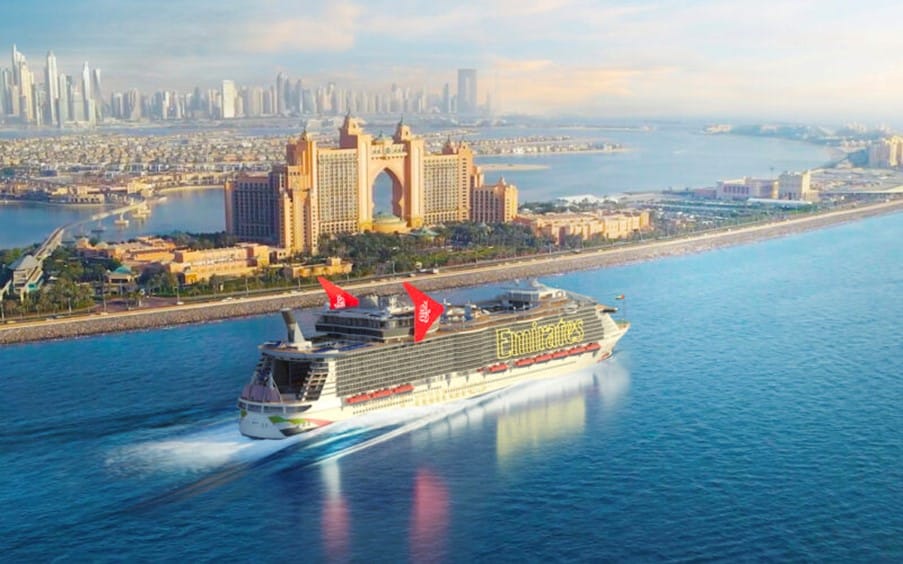Aerospace
Emirates is launching a cruise line with the purchase of ten cruise ships, with bookings beginning on April 1st.

Emirates, widely considered the QE2 among airlines and beloved by millions worldwide for its sumptuous services in the air and on land, will now be sailing across the seven seas with its newly-launched maritime arm, Emirates Sealine.
Lucky ship-spotters and cruise aficionados witnessed glimpses of the first liner as it majestically sailed around Dubai’s Palm Jumeirah earlier today on its maiden sea trial – click here.
Emirates Sealine is promising cruisers top-tier and never-before-imagined experiences as they voyage to rarely-before-seen ports of call. It placed a titanic, multi-billion-dollar order for an initial 10 cruise ships which are currently being fitted with the latest and the best.
Having identified significant gaps in the industry’s offering, Emirates Sealine will give a wide berth to the convention, offering a cruise calendar outside traditional seasons. The first cruise is scheduled to flag off from Dubai Harbour on 01 April 2024, with Karachi as the maiden port of call – harking back to the airline’s first-ever flight in October 1985.
Itineraries and bookings will be open from 31 June. Emirates Sealine’s liners will dock at major cruise ports – charting a course from the US to New Zealand – supported by the airline’s colossal network.
Captain Jack Shallow, the newly appointed Chief Maritime Officer at the helm of Emirates Sealine said: “Emirates is no stranger to the seas, having been associated with powerboat racing in Dubai to Emirates Team New Zealand and more recently, the Emirates Great Britain SailGP Team. While cities worldwide remain moored to challenges, Dubai is sailing smoothly at unimaginable knots and has outstanding cruise and other multi-modal transport infrastructure.
“Technology, AI, and innovation in developing our future-generation cruise ships mean we can mirror the city’s pace and sail at more than 50 knots per hour – nearly double the speed of the fastest ones today. We’re working on providing undreamed-of luxury onboard, never-before-explored itineraries and once-in-a-lifetime experiences. We’ll be running a tight ship to ensure we deliver on our promises to our customers. Right now, it’s all hands to the deck as the team prepares for launch.”
Emirates Sealine will set the industry’s pace around maritime sustainability by working with vendors on sustainable maritime fuel (SMF), solar panels, recycling, and waste management.
Emirates’ passengers, arriving in style from across the airline’s global network to Dubai, will be whisked off in custom-built electric chauffeur-driven cars from DXB to Dubai Harbour and escorted to their luxury cabins onboard, in a seamless air-land-sea journey.
The cruise fleet will feature four cabin types, offering varied and tiered levels of space, amenities, and luxury. More product and service details may be released in the future.
Over the next months, Emirates Sealine will recruit thousands of mariners and specialists with a diverse range of skills and expertise to manage operations and serve guests with the airline’s signature hospitality, supporting economies across its network. Recruitment information will shortly be available on Sealine’s website.
NOTE : If you think this is true, this is April Fool’s Day for you.

Aerospace
Boeing Transfers Rocket Stage to NASA, Paving Way for Human Moon Mission

Boeing has achieved a significant milestone by providing NASA with the second core stage of the Space Launch System (SLS) rocket.
This crucial component, crafted at NASA’s Michoud Assembly Facility (MAF), is set to propel the Artemis II crew into lunar orbit, marking humanity’s return to deep space after a 50-year hiatus.
The monumental Boeing-built rocket stage, the largest element of the Artemis II mission, will embark on a journey aboard the Pegasus barge, traveling 900 miles to NASA’s Kennedy Space Center.
Comparison of two legendary aircraft B777x vs B747 aircraft:Click here
Upon arrival, it will be meticulously integrated with other essential Artemis II components, including the upper stage, solid rocket boosters, and NASA’s Orion spacecraft within the iconic Vehicle Assembly Building. This intricate integration process is a vital step toward the eagerly anticipated Artemis II launch, slated for 2025.
“Boeing-built products helped land humankind on the moon in 1969, and we’re proud to continue that legacy through the Artemis generation,” remarked Dave Dutcher, vice president and program manager for Boeing’s SLS program. “Together, with NASA and our industry partners and suppliers, we are building the world’s most capable rocket and paving the way to deep space through America’s rocket factory in New Orleans.”
NASA, Lockheed Martin Reveal X-59 Quiet Supersonic Aircraft:Click here
The delivery of Core Stage 2 marks a significant achievement in the evolution of the SLS rocket. Towering over 200 feet and powered by four RS-25 engines, this core stage, coupled with two solid-fueled booster rockets, will generate a staggering 8.8 million pounds of thrust. This immense power is crucial to launching Artemis II and future missions into the vast expanse of space.
The SLS rocket stands unparalleled in its capability to transport both crew and substantial cargo to the moon and beyond in a single launch. Its extraordinary capacity will facilitate the delivery of human-rated spacecraft, habitats, and scientific missions to destinations including the moon and Mars, ushering in a new era of space exploration.
-

 Travel1 week ago
Travel1 week agoAir India to Expand US Operations with Three New Routes After a Decade
-

 Travel2 weeks ago
Travel2 weeks agoWhy We Should Avoid These Stamps in a Passport
-

 Airlines1 month ago
Airlines1 month agoInvestigations Reveal Fake Chinese Titanium in Boeing and Airbus Jets
-

 Tech4 weeks ago
Tech4 weeks agoChina’s CATL Plans 1,800-Mile Electric Plane Launch by 2027
-

 Airport3 days ago
Airport3 days agoTop 10 Largest Airports in the World by Size
-

 Aerospace4 weeks ago
Aerospace4 weeks agoChina’s Fighter Jets Turn Wings into Autonomous Drones
-

 Airlines4 days ago
Airlines4 days agoAir India Rolls Out A350s for Delhi-New York JFK and Newark Routes
-

 Defence3 weeks ago
Defence3 weeks agoBoeing Enhances Chinook with New Engines and Block II Upgrades at $96 Million







